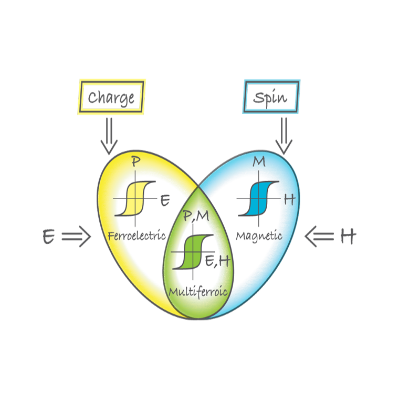Magnetoelectric coupling in core/shell nanocomposites
Contact person and project supervisor: Dr. Dominika Zákutná, zakutnad@natur.cuni.cz
Project description:
Multiferroic materials combine two or more ferroic properties (Fig. 1), which coexist and are coupled together in the same phase[1]. These materials attracted a great attention due to their possible applicability in spintronics[2]. Usually, materials have ferroelectric properties emerged with antiferromagnetic behavior, as for instance in perovskite structures (RMO3). Another type of multiferroic behavior was found for chromite spinel structure (CoCr2O4), where ferroelectricity arises from the spin-spiral magnetic structure formed due to the strong direct exchange interactions[3,4]. Problematic of magnetoelectric (ME) coupling is that it occurs only at very low temperatures or high magnetic fields in multiferroic materials[5]. Thus, a new type of material is in research, where ME coupling could be induced through a strain. Core/shell nanoparticle are good candidates for tailoring multifunctionalities thanks to the large interfacial area. Promising type of core/shell nanoparticles are where ferrimagnetic and piezoelectric structures are combined. The reason is that core material is surrounded by a shell with a well-defined interface, where a strain in the core or shell part could enhance coupling between two ferroic orders causing ME coupling. The scope of the Phd project is to synthesize pure core and core/shell nanoparticles of ferrimagnetic/piezoelectric (or piezoelectric/ ferrimagnetic) composition and to perform characterization of possible coupling between two ferroic properties and its origin. The samples will be prepared using thermal decomposition method[6], which is a very well established nanoparticle synthesis with good control over the particle size, size distribution, and shape. The morphological and structural properties of core/shell nanoparticles will be studied with a combination of different scattering techniques (wide- and small-angle scattering) and imaging techniques (high-resolution transmission microscopy). The magnetic properties and possible ferroic coupling in prepared nanoparticles will be studied by macroscopic magnetization and polarization measurements. Moreover, the spatially resolved magnetic structure and origin of the ME coupling at the microscopic level will be in-depth studied by neutron scattering experiments.
Profile of the candidate: MSc. or equivalent in Chemistry or Material science, advanced in English

Fig. 1. Schematic presentation of multiferroic behavior[1].
References:
[1] D. Khomski, Physics 2, 20 (2009).
[2] M. Fiebig, T. Lottermoser, D. Meier, and M. Trassin, Nat. Rev. Mater. 1, 16046 (2016).
[3] D. Zákutná et al., Phys Rev B 98, 064407 (2018).
[4] D. Zákutná et al., Phys Rev B 100, 184427 (2019).
[5] S.-W. Cheong and M. Mostovoy, Nature Mater. 6, 13 (2007).
[6] E. Wetterskog et al, Sci. Technol. Adv. Mater. 15, 055010 (2014).
Deadline is closed